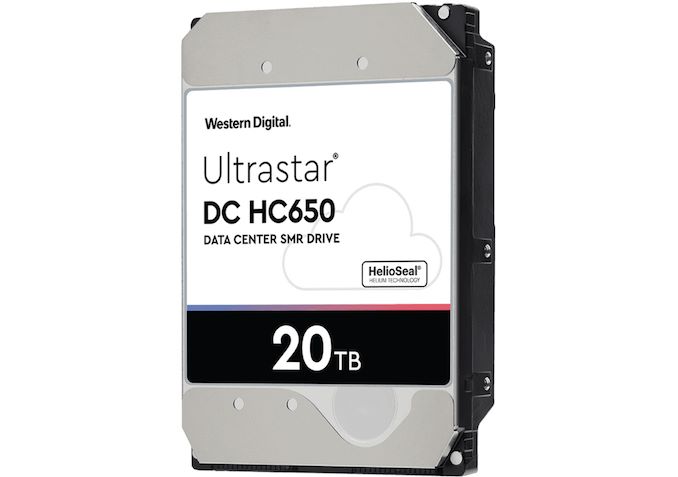Western Digital 20 TB HDD: Crazy Capacity for Cold Storage
by Anton Shilov on September 11, 2019 9:30 AM EST
As operators of cloud datacenters need more storage capacity, higher capacity HDDs are being developed. As data hoarders need more capacity, higher capacity HDDs are needed. Last week Western Digital introduced its new Utrastar DC HC650 20 TB drives - hitting a new barrier in rotating data.
The drives feature shingled magnetic recording (SMR) technology, which layers data on top of another much like a shingled roof, and therefore is designed primarily for write once read many (WORM) applications (e.g., content delivery services). Western Digital’s SMR hard drives are host managed, so they will be available only to customers with appropriate software.
Western Digital’s Utrastar DC HC650 20 TB is based on the company’s all-new nine-platter helium-sealed enterprise-class platform, a first for the company. The new 3.5-inch hard drives feature a 7200 RPM spindle speed and will be available with a SATA 6 Gbps or SAS 12 Gbps interface depending on the SKU. Since the product is not expected to be available immediately, the manufacturer does not disclose all of its specifications just yet, but has stated that key customers are already in the loop.
Featuring a very high per-platter capacity of around 2.2 GB, the Utrastar DC HC650 20 TB HDDs offer a higher sequential read performance than its predecessors, but its read IOPS per TB performance is lower than that of older HDDs. That said, Western Digital’s clients who will use the 20 TB SMR HDDs will need to mitigate two things: manage physical limitations of SMR by maximizing sequential writes (and minimizing random writes) as well as take into account lower IOPS per TB performance to minimize impact on their QoS.
As far as availability is concerned, the 20 TB version of the Ultrastar DC HC650 SMR drives will be available as samples by the end of the year. Actual shipments will start once the drives are qualified by customers. Because the HDDs will be available to select customers only, Western Digital does not publish per-unit pricing.
Related Reading
- New Hlo 15TB HDDs: Western Digital Unveils the Ultrastar DC HC620
- Western Digital’s Ultrastar DC HC330: A 10 TB HDD for Enterprises w/ 40% Faster Writes
- Western Digital Launches Ultrastar DC HC530 14 TB PMR with TDMR HDD
Source: Western Digital










50 Comments
View All Comments
eastcoast_pete - Wednesday, September 11, 2019 - link
@Anton, I thought that these drives reach their density by, yes, shingled arrangement, but especially by using MAMR (microwave-assisted magnetic recording) ? I didn't see mentioning of it in your note. Can you confirm or correct whether these are MAMR drives? If yes, that would be the key news: WD ready to ship MAMR drives.DanNeely - Wednesday, September 11, 2019 - link
At this point I'm assuming not. If these were the first MAMR drives WD would be shouting it to the rooftops.YB1064 - Wednesday, September 11, 2019 - link
For anybody interested, a good introductory article was published in IEEE spectrum:https://spectrum.ieee.org/computing/hardware/laser...
Another one from 2009:
https://spectrum.ieee.org/computing/hardware/laser...
DanNeely - Wednesday, September 11, 2019 - link
In some ways I think the most interesting bit is that the 2tb 3.5" non-SMR platters mean density has finally hit the point of 1tb 2.5" platters. That means for people who need more space to go than is affordable in NAND, but who don't want to lug a power brick should finally be able to get 3TB 2.5" drives in standard thicknesses, instead of the long term top out at only 2tb.Samus - Thursday, September 12, 2019 - link
Damn WD made a solid investment buying HGST.not_anton - Thursday, September 12, 2019 - link
I tried to use SMR external drive for work... these 3 IOPS in random writes still give me shivers!mode_13h - Saturday, September 14, 2019 - link
OMG. Did you not know? Or you were just hoping for more like 30 IOPS?danwat1234 - Friday, September 13, 2019 - link
Host managed? What does that mean. The drives controller lag some functionality that only specific motherboard chips can perform? I don't see any advantageJohn_M - Friday, September 13, 2019 - link
Host-managed means that the controller queries the drive about its geometry and uses the information to make intelligent decisions about where to write on its surface. It's the opposite of device-managed where the controller treats the drive as a conventional one and lets it make its own decisions.lukx - Saturday, October 31, 2020 - link
it's almost end of 2020 and still those drives are not available...why?